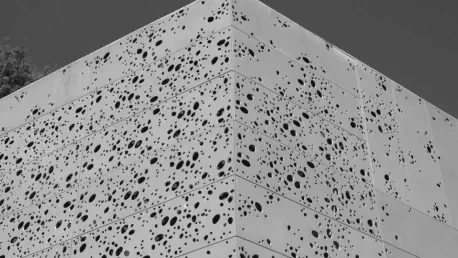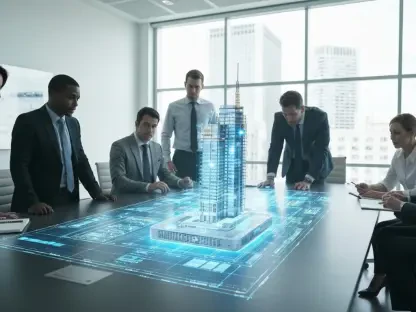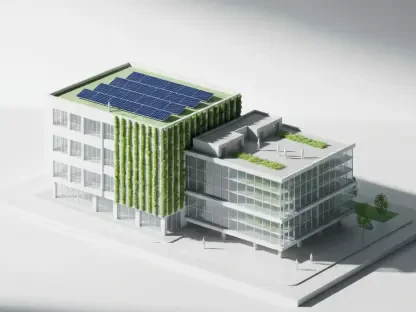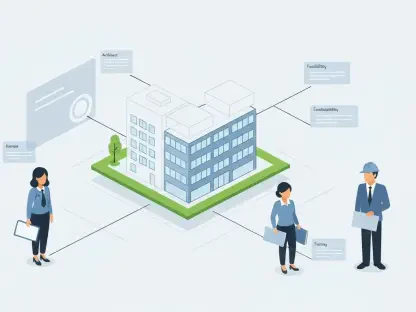The rise of sustainable construction is transforming the building industry, leading to significant growth in the polymer concrete market. With increasing environmental concerns and regulatory policies advocating for greener building practices, polymer concrete is becoming a preferred material due to its exceptional properties and environmental benefits. This article delves into the various factors driving this market growth, the challenges to overcome, and the opportunities ahead.
Market Outlook and Forecast
Projected Market Growth
The polymer concrete market is on a robust growth trajectory, projected to reach USD 541.4 million by 2024, and approximately USD 1,158 million by 2034. This expansion underscores a strong compound annual growth rate (CAGR) of 7.9%, largely driven by the material’s superior durability, chemical resistance, and enhanced structural integrity. As builders aim for long-lasting construction solutions, polymer concrete’s robust properties make it an ideal choice.
This significant market growth is influenced by the global shift towards sustainable construction, which demands materials that can withstand harsh environmental conditions and reduce the carbon footprint. Polymer concrete’s resistance to chemicals and environmental stressors makes it a top contender for such applications. Moreover, as urbanization accelerates, particularly in emerging economies, there is a pressing need for materials that can endure the rigors of modern infrastructure projects, providing both durability and sustainability.
Adoption and Demand
Adoption of polymer concrete is escalating due to its ability to cater to diverse applications, including transportation infrastructure, industrial flooring, and wastewater management. Builders and developers are increasingly opting for these materials to meet the growing demand for sustainable construction solutions, further boosting market growth. The versatility of polymer concrete allows it to adapt to various needs, making it indispensable for modern construction.
The material’s adaptability ensures that it can be used for myriad applications, from highways and bridges to commercial flooring and containment systems. Its low permeability and high strength mean that structures require less maintenance over their lifespan, offering cost savings in the long term. Additionally, as green building certifications become more sought after, the use of polymer concrete helps builders meet stringent environmental criteria, thereby making it an essential component of eco-friendly construction.
Drivers of Market Growth
Environmental Awareness and Green Building Practices
Growing global awareness regarding environmental issues has spurred a shift towards sustainable construction practices. Regulatory bodies are pushing for materials that offer reduced environmental impact and enhanced lifecycle performance. Polymer concrete stands out in this regard, appealing to eco-conscious builders eager to construct greener buildings. The surge in green building certifications and initiatives further catalyzes the adoption of sustainable materials.
This trend is not just driven by regulatory pressures but also by an increasing demand from consumers and organizations aiming to minimize their environmental footprint. As environmental concerns take center stage, the construction industry is poised to adopt materials that align with sustainable practices. Builders are progressively seeking materials that offer both durability and a lower ecological impact, and polymer concrete fits this bill perfectly, making it a cornerstone of eco-friendly construction projects.
Superior Properties of Polymer Concrete
Polymer concrete is revered for its high strength, durability, chemical resistance, and low permeability. These properties make it an ideal choice for various high-demand applications, thereby driving its adoption. Its robustness ensures long-lasting structures that require less maintenance, contributing to long-term sustainability. In addition to its strength, polymer concrete offers unparalleled resistance to chemicals, making it suitable for industrial applications.
The low permeability of polymer concrete means that it is highly resistant to freeze-thaw cycles, which is a significant advantage in climates with harsh winters. Moreover, its chemical resistance makes it ideal for industrial settings where exposure to harsh substances is common. These attributes allow polymer concrete to be a versatile material, adapting to a range of construction environments and reducing the need for frequent repairs or replacements. The combination of these features makes it highly attractive for both developers and end-users.
Infrastructure Development
The surge in infrastructure development, especially in emerging economies, significantly bolsters the demand for polymer concrete. The global trend towards urbanization and modernization necessitates materials that support sustainable construction, positioning polymer concrete as a key player in future infrastructure projects. As governments and private sectors invest in new infrastructure, the demand for durable and sustainable materials like polymer concrete is expected to soar.
Urbanization is a key driver, with cities expanding and infrastructure needs multiplying. Emerging economies, in particular, are seeing rapid growth in road networks, bridges, and public facilities, all requiring materials that can provide long-lasting performance. Polymer concrete, with its high durability and resistance to harsh environmental conditions, fits these needs perfectly. Additionally, mature markets are also investing in infrastructure renewal projects, further driving the demand for modern construction solutions.
Challenges Facing the Market
Higher Initial Costs
Despite its numerous benefits, polymer concrete often comes with higher initial costs compared to traditional materials. This price factor can act as a deterrent, particularly in cost-sensitive markets where the upfront investment might be a significant concern for stakeholders. The higher costs are often attributed to the complex production processes and the use of advanced materials in polymer concrete.
However, it’s essential to consider the long-term cost benefits that polymer concrete offers. Its durability and low maintenance requirements can result in significant savings over the lifespan of the structure. Educating the market on these long-term benefits can help mitigate concerns about the upfront costs. Moreover, as technology advances and production processes become more efficient, the initial costs of polymer concrete are projected to decrease over time, making it more competitive with traditional construction materials.
Lack of Awareness and Education
Limited awareness among contractors, engineers, and project owners about the benefits and applications of polymer concrete hinders its broader acceptance. Educating these stakeholders about the advantages of polymer concrete can play a crucial role in overcoming this challenge and boosting market growth. Efforts to increase awareness through training programs, seminars, and industry conferences can help bridge the knowledge gap and promote the adoption of polymer concrete.
The construction industry, traditionally reliant on conventional materials, needs comprehensive education to understand the full potential of polymer concrete. Demonstrating successful case studies and providing tangible evidence of its benefits can sway skeptical stakeholders. Furthermore, manufacturers can collaborate with engineering and architectural institutions to incorporate polymer concrete into academic curricula, ensuring that new generations of professionals are well-versed in its applications and benefits.
Opportunities for Market Expansion
Technological Advancements
Innovations in polymer formulations, manufacturing processes, and installation techniques are fostering market growth. These advancements enhance the performance of polymer concrete solutions, making them more attractive to the construction industry. Tailoring these innovations to meet evolving industry needs can unlock new growth avenues. Technological improvements can lead to more efficient production methods, reducing costs and making polymer concrete more accessible.
Breakthroughs in polymer chemistry are enabling the development of formulations with enhanced properties, such as increased chemical resistance, improved durability, and faster curing times. Advances in manufacturing techniques, such as automated production lines, can also lower production costs and speed up delivery times. As these technologies evolve, they not only enhance the quality of polymer concrete but also make it a more viable option for a wider range of applications. Companies that invest in R&D to drive these innovations are likely to gain a competitive edge in the market.
Niche Segments and Sustainable Construction
Expanding into niche segments within the sustainable construction sphere presents substantial opportunities for market players. By focusing on green building practices and differentiating their offerings, manufacturers can capture larger market shares and establish a competitive edge in this evolving marketplace. Areas such as eco-friendly urban development, green-certified construction projects, and energy-efficient buildings offer lucrative opportunities.
Niche markets, often underexplored, provide a fertile ground for growth. For instance, specialized applications in waste management facilities, chemical containment systems, or sustainable urban furniture present unique challenges that polymer concrete is well-equipped to meet. By developing targeted solutions for these niche applications, manufacturers can not only meet existing demands but also create new markets for their products. The focus on sustainability and green construction is likely to continue growing, making it imperative for market players to align their strategies accordingly.
Market Segmentation and Key Segments
By Material Type
The market is segmented into various material types, including Polyester, Vinyl Ester, Epoxy-Based, and others. The epoxy-based segment is particularly noteworthy, expected to hold a 30.1% market share by 2024, due to its superior performance characteristics. Epoxy-based polymer concrete offers enhanced mechanical properties and chemical resistance, making it ideal for high-stress environments.
Vinyl Ester and Polyester are also widely used due to their unique properties. Vinyl Ester, for example, is known for its excellent adhesion and chemical resistance, making it suitable for applications in harsh industrial environments. Polyester-based polymer concrete, while generally less expensive, offers a good balance of performance and cost, making it a versatile choice for various applications. The diversity in material types allows for customization and optimization, catering to specific project requirements and expanding the market’s reach.
By Resin Type
Polymer concrete can be categorized into natural resin and synthetic resin types. This segmentation allows for a diverse range of applications, catering to specific needs within the construction industry and contributing to market growth. Natural resins, derived from organic sources, offer eco-friendly alternatives, aligning with the global shift toward sustainable materials.
Synthetic resins, on the other hand, provide enhanced performance characteristics, including greater durability and chemical resistance. These attributes make synthetic resins suitable for demanding applications where high performance is essential. The choice between natural and synthetic resins allows builders to select materials that best meet their project’s specific requirements, whether the priority is sustainability, cost, or performance. This flexibility in resin types supports the broader adoption of polymer concrete across various sectors.
By Application
Polymer concrete is used in a multitude of applications such as solid surfaces, countertops, outdoor seats and benches, waste containers, pump bases, flooring blocks, chemical containments, and trench drains. Its versatility makes it a sought-after material across various construction projects. Each application leverages the unique properties of polymer concrete, ensuring durability and performance.
For instance, in transportation infrastructure, the high strength and low permeability of polymer concrete make it ideal for use in bridges, roadways, and airport pavements. In industrial settings, its chemical resistance is paramount for flooring in factories or containment systems for chemical plants. The versatility of polymer concrete extends to residential and commercial applications, where its aesthetic appeal and strength make it suitable for countertops, outdoor furniture, and architectural elements. This wide range of applications underlines the material’s adaptability and comprehensive utility in modern construction.
By End-Use
The market serves several end-use sectors, including industrial (energy & utilities, pulp & paper, chemicals, metallurgy, food processing, automotive), residential & municipal (buildings, roadways, pipes & tunnel liners, bridges), and commercial (service stations, retail spaces). The residential & municipal segment is projected to account for about 47.6% market share by 2024. This dominance is driven by the ever-growing need for durable and sustainable materials in public infrastructure projects.
Industrial applications also constitute a significant portion of the market, where the material’s resistance to harsh chemicals and mechanical stress is highly valued. The commercial sector, encompassing retail spaces and service stations, benefits from polymer concrete’s durability and ease of maintenance. Each end-use sector has distinct requirements, but they all share a common need for materials that offer long-term performance, sustainability, and cost-effectiveness. The broad applicability across sectors enhances the market’s growth prospects and ensures its relevance in future construction projects.
Regional Market Analysis
United States
The U.S. polymer concrete market is expected to register a CAGR of 4.4% by 2034, driven by infrastructure renewal projects and the adoption of sustainable materials, aligning with the country’s commitment to green building practices. As aging infrastructure demands urgent upgrades, the need for durable and sustainable construction materials becomes more pressing. Polymer concrete’s superior properties make it a preferred choice for these projects.
The U.S. market is also influenced by stringent building codes and sustainability standards, which promote the use of eco-friendly materials. With increasing investments in public infrastructure and private construction projects, the demand for polymer concrete is set to rise. Furthermore, federal and state initiatives aimed at promoting sustainable construction practices are likely to provide additional impetus to market growth. The focus on infrastructure development and sustainability in the U.S. makes it a significant market for polymer concrete.
United Kingdom
In the UK, the market is projected to grow at a CAGR of 3.1% by 2034, influenced by stringent building regulations and sustainability initiatives that promote the use of environmentally friendly construction materials like polymer concrete. The UK’s commitment to reducing carbon emissions and promoting green building practices is a key driver of this growth.
The market in the UK is further bolstered by ongoing infrastructure projects, including upgrades to transportation networks and public facilities. The adoption of polymer concrete aligns with the country’s broader goals of enhancing sustainability and resilience in construction. Moreover, the emphasis on lifecycle performance and reduced maintenance costs makes polymer concrete an attractive material for both public and private sector projects. The UK’s proactive stance on sustainability and stringent regulatory environment underscore the importance of polymer concrete in the country’s construction landscape.
Competitive Landscape
The growth in sustainable construction is revolutionizing the building industry, significantly boosting the market for polymer concrete. Heightened environmental awareness and stricter regulatory measures advocating for eco-friendly construction methods are pushing polymer concrete to the forefront. This material is gaining favor due to its outstanding properties and environmental advantages.
Polymer concrete is not just a trend; it’s a substantial shift driven by several key factors. These include its durability, resistance to chemicals, and reduced lifecycle costs compared to traditional materials. As governments and organizations push for green building solutions, the adoption of polymer concrete is poised to rise further.
However, the market does face challenges. The relatively high initial cost and the need for specialized labor to work with polymer concrete are obstacles that must be addressed. Despite these hurdles, the future looks promising due to ongoing innovations and increasing public and private sector investments in sustainable construction. The market for polymer concrete is expected to expand as it aligns perfectly with the global paradigm shift towards more sustainable, eco-conscious building practices.









